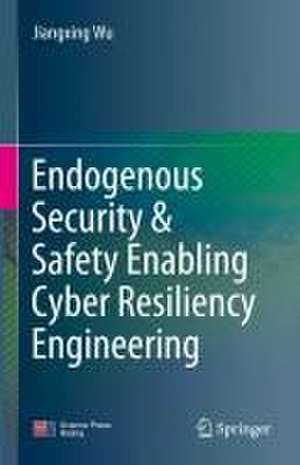Cyber Resilience System Engineering Empowered by Endogenous Security and Safety
Autor Jiangxing Wuen Limba Engleză Hardback – 15 sep 2024
Preț: 1017.86 lei
Preț vechi: 1272.33 lei
-20% Nou
Puncte Express: 1527
Preț estimativ în valută:
194.77€ • 212.23$ • 164.12£
194.77€ • 212.23$ • 164.12£
Carte tipărită la comandă
Livrare economică 19-25 aprilie
Preluare comenzi: 021 569.72.76
Specificații
ISBN-13: 9789819701155
ISBN-10: 9819701155
Pagini: 422
Ilustrații: Approx. 420 p.
Dimensiuni: 155 x 235 mm
Ediția:2024
Editura: Springer Nature Singapore
Colecția Springer
Locul publicării:Singapore, Singapore
ISBN-10: 9819701155
Pagini: 422
Ilustrații: Approx. 420 p.
Dimensiuni: 155 x 235 mm
Ediția:2024
Editura: Springer Nature Singapore
Colecția Springer
Locul publicării:Singapore, Singapore
Cuprins
Chapter 1. Cyberspace Endogenous Security and Safety Problems.- Chapter 2. Cyberspace Endogenous Security and Safety Defense Vision.- Chapter 3. The Principle and Structure of Cyberspace Endogenous Security and Safety.- Chapter 4. Introduction to Functional Safety and Cyber Resilience.- Chapter 5. The Framework of Cyber Resilience Engineering Empowered by Endogenous Security and Safety.- Chapter 6. Metrics and Assessment of ESS-Empowered Cyber Resilience.- Chapter 7. Engineering Applications in Typical Fields of ESS Empowerment.- Chapter 8. Exploration of Emerging Fields Empowered by Endogenous Security and Safety.- Appendix.
Notă biografică
Wu Jiangxing, academician of the CAE Member, born in 1953, is a famous scientist and engineer in the fields of network and communication, computer architecture and cyber security in China. In 2008, he proposed a multi-dimensional reconfigurable hardware and software collaborative computing architecture based on active cognition – Mimic Computing Architecture (MCA), which was rated as “China’s top ten scientific and technological progress” in 2013 by academicians of the Chinese Academy of Sciences and the Chinese Academy of Engineering. In 2013, the Cyberspace Mimic Defense (CMD) theory of endogenous security and safety based on structure coding was founded, which proved that the inference of “structure determines security” derived from the axiom of “structure determines function” was established in theoretical and engineering sense, and opened up a new direction of structure encryption besides information encryption for security and confidentiality. Since 2017, he has successively published the Chinese monographs “Introduction to Cyberspace Mimic Defense”, “Principles of Cyberspace Mimic Defense”, “Endogenous Security and Safety in Cyberspace” and the English monographs “Cyberspace Mimic Defense: Generalized Robust Control and Endogenous Security and Safety”.
Textul de pe ultima copertă
This book reveals the essence of endogenous or internal contradictions in cyberspace security issues, systematically expounds the principle of cyberspace endogenous security and safety, introduces the author-invented dynamic heterogeneous redundant (DHR) architecture with endogenous security and safety features, and theoretically answers why DHR endogenous security and safety architecture can enable network resilience engineering; the enabling role of DHR architecture solves the problem that network resilience cannot cope with unknown damage, lacks structural gain, and cannot quantify design measures. This book analyses the systematic security gains that DHR architecture enabling network resilience engineering can bring in the four purpose dimensions of prevention, defense, recovery and adaptation; gives an application example of DHR endogenous security and safety architecture enabling network resilience engineering; introduces the research and exploration of endogenous security and safety theory in wireless communication security, artificial intelligence security and other derivative application fields; and uses rich application examples. It shows that the endogenous security and safety architecture enabling network resilience engineering not only is very necessary but also has universal application significance. This book is suitable for postgraduate teaching materials or reference books of related disciplines, such as cybersecurity, network resilience engineering, confidential computing/trusted computing, information physical systems/industrial control, etc.
Caracteristici
Analyses reasons why the current network security technology cannot effectively prevent unknown security problems Introduces dynamic heterogeneous redundancy (DHR) architecture and explains how it applies Provides applications of endogenous security and safety architecture enabling network elasticity engineering
